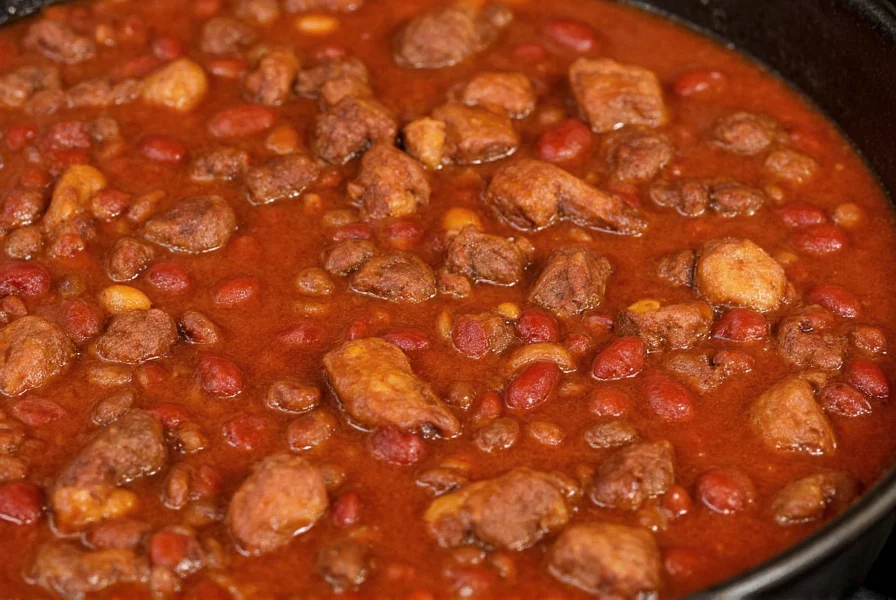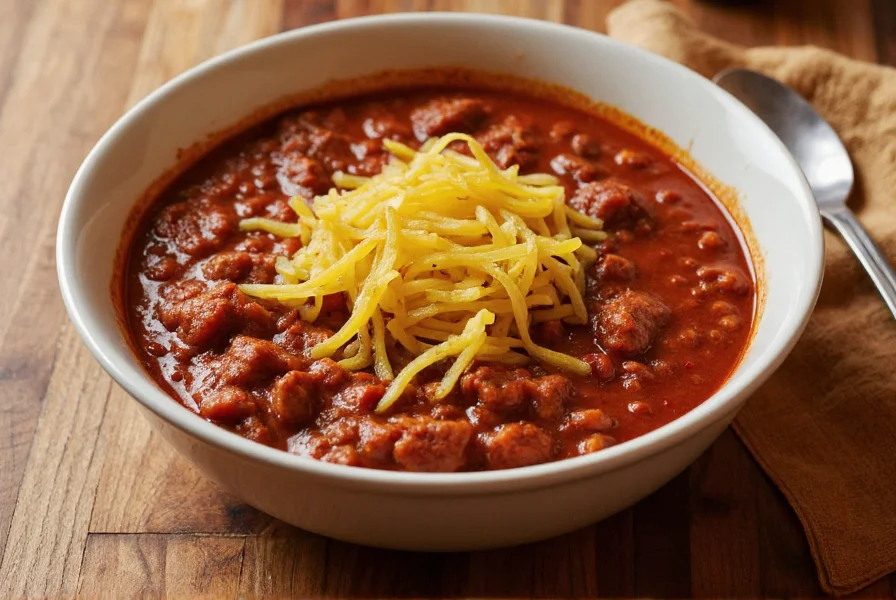When you ask what is chili con carne, you're exploring one of America's most beloved comfort foods with surprising historical depth. Unlike common misconceptions, traditional chili con carne (Spanish for "chili with meat") contains only meat, chili peppers, and spices—no beans, tomatoes, or other ingredients often added in modern variations.
The essence of authentic chili con carne lies in its simplicity and depth of flavor. Skilled cooks build complex taste profiles by carefully toasting and rehydrating dried chili peppers like ancho, guajillo, and chipotle before blending them into a rich, flavorful base. This chili paste forms the foundation that transforms browned beef chunks into the hearty stew celebrated at cook-offs across Texas.
Historical Origins of Chili Con Carne
Chili con carne emerged in the late 19th century among working-class communities in Texas and northern Mexico. Immigrant populations—including Canary Islanders who settled in San Antonio in the 1700s—combined available ingredients with culinary traditions from Spain, Mexico, and indigenous cultures.
San Antonio's "Chili Queens," mostly Mexican American women, popularized the dish by selling it from街头 food stalls as early as the 1880s. These vendors prepared large pots of chili that fed railroad workers, soldiers, and locals, establishing chili con carne as a cultural staple. The dish gained national attention when it appeared at the 1893 Chicago World's Fair, launching its journey to becoming an American classic.
Authentic Ingredients Breakdown
Understanding what is chili con carne made of requires examining its essential components. Traditional recipes maintain strict ingredient limitations that distinguish authentic versions from modern adaptations.
| Essential Ingredients | Optional Additions | Non-Traditional Elements |
|---|---|---|
| Beef (chuck or brisket) | Garlic | Beans (kidney, pinto) |
| Dried chili peppers | Onion | Tomatoes or tomato paste |
| Cumin | Beef broth | Corn |
| Salt | Bay leaves | Rice or other grains |
The bean controversy represents one of the most heated debates in chili circles. Traditional Texas-style chili con carne contains no beans, as purists argue they dilute the meat's flavor and texture. Organizations like the Texas Chili Cook-off Association explicitly prohibit beans in their competition categories. However, many home cooks and regional variations incorporate beans for added texture and nutrition.
Regional Variations Across America
While Texas-style remains the most authentic representation of what chili con carne really is, regional interpretations have evolved across the United States:
- Texas Red: Strict meat-and-chili-pepper preparation, often without vegetables
- Cincinnati Style: Features chocolate or cocoa powder and served over spaghetti
- Midwest Variations: Typically include beans, tomatoes, and sometimes even kidney beans
- California Style: May incorporate wine or coffee for depth of flavor
These variations demonstrate how chili con carne has adapted to local tastes while maintaining its core identity as a meat-centric chili pepper stew. The International Chili Society recognizes multiple categories in competition cooking, acknowledging both traditional and creative interpretations.
How to Identify Authentic Chili Con Carne
When evaluating what is authentic chili con carne, consider these distinguishing characteristics:
- Texture: Should feature tender meat chunks suspended in thick, rich sauce—not a soupy consistency
- Color: Deep reddish-brown from properly prepared chili peppers, not bright red from tomatoes
- Flavor Profile: Complex heat with earthy, smoky notes rather than acidic tomato flavor
- Ingredient List: Short and focused on meat and chili peppers as primary components
Professional chili makers often judge authenticity by the "coat of arms" test—when a spoon stands upright in properly thick chili. This texture results from the natural gelatin in meat and reduction of chili pepper liquids, not from added thickeners.
Modern Culinary Significance
Today, chili con carne maintains its status as both comfort food and competitive culinary art. The dish has evolved beyond its working-class origins while preserving its essential character. Food historians recognize it as one of America's earliest fusion cuisines, blending Spanish, Mexican, and indigenous culinary traditions.
Understanding the true definition of chili con carne helps appreciate why it remains popular across generations. Its versatility allows for both strict traditional preparation and creative adaptations, making it equally at home in backyard cookouts and fine dining establishments. The dish's ability to showcase quality ingredients while remaining accessible to home cooks ensures its continued relevance in American food culture.

Common Misconceptions Clarified
Several myths surround what chili con carne actually is, often confusing it with related dishes:
- Chili con carne vs. chili verde: While chili con carne uses dried red chilies, chili verde features green tomatillos and fresh green chilies
- Chili con carne vs. chili sin carne: The "sin carne" version is vegetarian chili, often containing beans and vegetables
- Chili powder origin: Commercial chili powder blends (containing cumin, garlic, oregano) didn't exist when chili con carne originated—traditional versions use pure ground dried chilies
These distinctions matter when exploring the authentic history of chili con carne. The dish's evolution reflects broader patterns in American food history, where immigrant traditions adapt to new environments while maintaining core identity.

Frequently Asked Questions
What is the literal translation of chili con carne?
Chili con carne translates from Spanish to 'chili with meat.' The term specifically distinguishes this meat-based chili stew from vegetarian versions like chili sin carne (chili without meat).
Does authentic chili con carne contain beans?
No, traditional Texas-style chili con carne does not contain beans. Authentic versions focus solely on meat, dried chili peppers, and spices. The bean controversy is longstanding, with purists arguing beans dilute the meat flavor that defines genuine chili con carne.
What are the essential ingredients in traditional chili con carne?
Authentic chili con carne requires only beef (typically chuck or brisket), dried chili peppers (like ancho, guajillo, or chipotle), cumin, and salt. Some variations include garlic and onion, but tomatoes, beans, and other fillers are not part of traditional recipes.
How is chili con carne different from regular chili?
Chili con carne specifically refers to the traditional meat-based version without beans or tomatoes. 'Regular chili' often refers to modern adaptations that may include beans, tomatoes, and other ingredients. The term 'chili' alone can describe both meat and vegetarian versions.
Where did chili con carne originate?
Chili con carne originated in late 19th century Texas among working-class communities, particularly San Antonio's Mexican American population. It evolved from culinary traditions blending Spanish, Mexican, and indigenous influences, with the 'Chili Queens' of San Antonio popularizing it through street food stalls in the 1880s.











 浙公网安备
33010002000092号
浙公网安备
33010002000092号 浙B2-20120091-4
浙B2-20120091-4